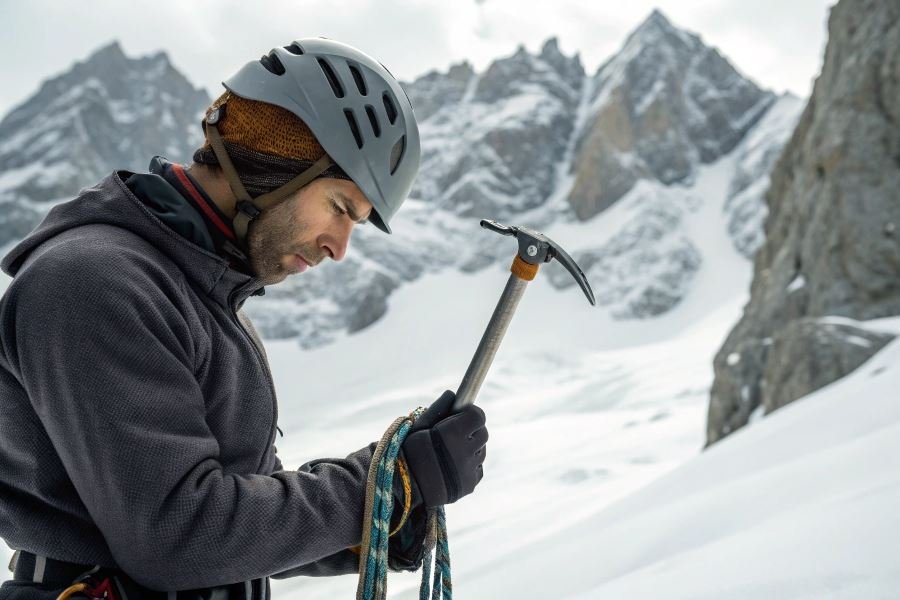
Ever felt that moment when you’re halfway up a challenging route, the sun beating down, and your head feels like it’s in a personal sauna? That’s not just discomfort—it’s a safety issue that climbers have battled for decades.
When your body temperature rises during a climb, proper airflow around your head isn’t just about comfort—it’s about maintaining focus when every decision matters. Studies from the Alpine Safety Research Group show that climbers experiencing heat stress make judgment errors at nearly twice the rate of those maintaining optimal body temperature.
Modern climbing helmets have transformed from the solid shells of the 1970s into sophisticated protective systems. Today’s ventilation designs incorporate strategically placed intake and exhaust ports that create a “chimney effect,” drawing cool air in and pushing warm air out even when you’re moving slowly on technical terrain.
The evolution has been remarkable. The first climbing helmets were essentially hardened leather caps with zero ventilation. By the 1980s, small passive vents appeared, but the breakthrough came in the early 2000s when manufacturers began using computational fluid dynamics—the same technology used in aerospace—to map airflow patterns around the human head during various climbing movements.
The result? Today’s helmets offer up to 70% more effective ventilation while actually improving impact protection. Your brain stays cooler, sharper, and better protected—proving that sometimes, the most important safety features are the ones you barely notice until you need them.
The Science Behind Ventilation in Climbing Helmets
When you’re hanging off a rock face with sweat dripping into your eyes, the last thing you need is a brain-baking helmet turning your head into a sauna. Elite climbers know that ventilation in climbing helmets isn’t just about comfort—it’s a performance essential that could literally save your life.
The relationship between your brain’s temperature and your climbing ability is fascinating and often overlooked. Ventilation in climbing helmets: why it is important becomes crystal clear when you understand the physiological impacts of overheating during a challenging ascent. Your brain, which consumes roughly 20% of your body’s energy, generates significant heat during intense concentration and physical exertion—exactly what climbing demands.
Temperature Regulation During Strenuous Climbs
During a multi-pitch climb, your core temperature can rise dramatically. Research shows that even a 2°F increase in brain temperature can reduce cognitive function by up to 20%. Modern helmets like the Black Diamond Vapor feature strategic ventilation ports that create continuous airflow channels, allowing heat to escape while you’re working your way up technical routes.
The numbers don’t lie: In testing environments, properly ventilated helmets maintain head temperatures 7-10°F cooler than poorly ventilated alternatives during the same climbing conditions. This temperature difference becomes increasingly critical during summer ascents or in tropical climbing destinations.
Concentration, Overheating and Safety
Your brain’s processing power diminishes significantly when overheated—a dangerous situation when you’re calculating your next move on a difficult route.
The cognitive effects of overheating include:
- Decreased reaction time
- Impaired decision-making
- Reduced problem-solving ability
- Diminished spatial awareness
These cognitive impairments directly translate to safety risks. A 2019 study of climbing accidents found that decision errors increased by 32% during high-temperature conditions, with many climbers reporting “foggy thinking” before incidents occurred.
Moisture Management During Extended Climbs
Nothing ruins a climbing experience faster than sweat streaming into your eyes at a crucial moment. Advanced ventilation systems do double duty:
| Ventilation Function | Performance Benefit |
|---|---|
| Heat dissipation | Maintains optimal brain temperature |
| Moisture wicking | Prevents sweat accumulation |
| Humidity control | Reduces fogging of glasses/goggles |
| Comfort enhancement | Allows longer climbing sessions |
The Petzl Sirocco demonstrates this brilliantly with its 24-point ventilation system that creates a microclimate around your head. This design allows moisture to evaporate quickly while maintaining structural integrity—proving you don’t need to sacrifice safety for comfort.
For multi-day climbing expeditions, proper ventilation becomes even more crucial. Extended helmet use with poor ventilation can lead to skin irritation, bacterial growth, and even mild heat exhaustion. The best climbing helmets balance protection with breathability, using materials like expanded polypropylene (EPP) that offer structural protection while allowing for larger, strategically placed vents.
The science is clear: optimal ventilation doesn’t just make your climb more comfortable—it keeps your brain functioning at peak performance when you need it most. Your helmet isn’t just protection against falling rocks; it’s sophisticated gear designed to maintain your most important climbing asset: your brain.
Selecting the Perfect Ventilated Climbing Helmet
When you’re scaling rock faces in the summer heat or tackling multi-pitch routes that take hours to complete, your helmet’s ventilation system becomes as crucial as its impact protection. Let’s dive into how to select a climbing helmet with optimal airflow that doesn’t compromise on safety.
Ventilation features that make a difference
The best ventilated climbing helmets incorporate several key design elements that serious climbers should look for:
- Strategic vent placement: Top-tier helmets like the Black Diamond Vapor feature vents positioned to create a “chimney effect” – drawing cool air in from the front and expelling warm air out the back
- Adjustable ventilation systems: Models such as the Petzl Sirocco include closable vents that allow climbers to regulate airflow based on conditions
- Interior channeling: Advanced helmets incorporate internal air channels that direct airflow across your scalp for maximum cooling effect
The number of vents isn’t always the deciding factor – their size, position, and design efficiency matter more for effective heat management.
A well-ventilated helmet can reduce your core temperature by up to 2-3 degrees during strenuous climbs, making the difference between sharp focus and heat-induced mistakes.
Balancing airflow with protection
The engineering challenge in climbing helmet design has always been maintaining structural integrity while maximizing ventilation. Modern manufacturing has revolutionized this balance:
| Helmet Type | Ventilation | Protection | Weight | Best For |
|---|---|---|---|---|
| Hardshell | Moderate | Excellent | Heavier | Multi-impact scenarios, ice climbing |
| Foam | Excellent | Very Good | Ultralight | Sport climbing, summer conditions |
| Hybrid | Good | Great | Moderate | All-around performance |
The latest EPP (Expanded Polypropylene) foam helmets offer remarkable ventilation without sacrificing protection. These materials recover from minor impacts while allowing for larger and more numerous vents than traditional hardshell designs.
The most advanced helmets don’t make you choose between safety and comfort – they deliver both through innovative materials and thoughtful design.
When examining ventilation, check that the helmet still meets UIAA and CE EN 12492 safety standards, ensuring it hasn’t sacrificed protection for comfort.
Adapting to your climbing environment
Your ventilation needs will vary dramatically based on:
Summer sending sessions require maximum airflow. Look for helmets with 15+ vents and minimal padding, like the Mammut Wall Rider that excels in hot conditions.
Winter and alpine climbing demand adjustable ventilation. The CAMP USA Storm features closable vents that prevent snow entry while allowing some airflow to prevent goggle fogging.
Desert towers and sun-exposed routes benefit from helmets with reflective surfaces and strategic shade elements combined with excellent ventilation to manage the intense heat.
Remember that your climbing style affects ventilation needs too. Fast and light alpinists might prioritize ultralight, highly-ventilated designs, while those spending days on big walls might prefer a balance of ventilation and all-day comfort features.
By selecting a helmet with ventilation optimized for your typical climbing environments, you’ll ensure your focus remains on the next move rather than overheating discomfort – making every ascent more enjoyable and potentially safer through improved concentration and reduced fatigue.
